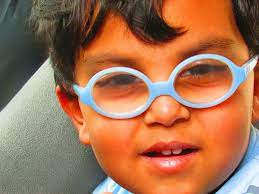Anisometropia is a common condition that occurs when there is a significant difference in the refractive error between the two eyes. Refractive error refers to the inability of the eye to properly focus light onto the retina which results in blurred vision.
Anisometropia
Anisometropia is characterized by a noticeable difference in the refractive power of the eyes. It can affect individuals of all ages (from infants to adults). The condition can occur in various forms and may manifest differently depending on the severity of the refractive error discrepancy.
Causes of Anisometropia
Anisometropia can have various causes, including:
Genetic Factors:
Anisometropia can be hereditary with a predisposition to variations in refractive error passed down through families. Genetic factors can contribute to the development of anisometropia. This is more common when both the parents have refractive error.
Eye Injuries or Surgeries:
Trauma to the eye or previous eye surgeries can lead to changes in the refractive error of one eye resulting in anisometropia. Injuries that affect the shape or structure of the eye can cause variations in the way light is focused.
Eye Conditions:
Certain eye conditions, such as cataracts or corneal irregularities can contribute to anisometropia. These conditions can affect the clarity and shape of the lens or cornea that can lead to differences in the refractive error between the eyes.
Amblyopia:
Anisometropia can be associated with amblyopia which is also known as “lazy eye.” Amblyopia occurs when the brain favors one eye over the other due to a significant difference in refractive error or other visual factors. The eye with poorer vision may develop amblyopia that may result into anisometropia.
Types of Anisometropia
There are three main types of anisometropia based on the nature of the refractive error difference:
1. Simple Anisometropia
Simple anisometropia refers to a significant difference in the refractive error between the two eyes that is typically caused by variations in the degree of nearsightedness (myopia), farsightedness (hypermetropia) or astigmatism. The degree of refractive error in one eye is significantly higher or lower than the other eye which results in imbalanced vision.
2. Compound Anisometropia
Compound anisometropia occurs when there is a difference in both the degree and the sign of refractive error between the two eyes. For example, one eye may have myopia while the other has hyperopia. This type of anisometropia can result in significantly different visual experiences between the two eyes.
3. Mixed Anisometropia
Mixed anisometropia involves a combination of simple and compound anisometropia. It is characterized by a difference in both the degree and the type of refractive error between the eyes. For instance, one eye may have myopia and astigmatism while the other eye has hyperopia and astigmatism. Mixed anisometropia can present complex challenges in vision correction and management.

Treatment
The management of anisometropia depends on various factors including the severity of the condition, the age of the individual and the presence of any associated visual abnormalities. Some common treatment options include:
Eyeglasses:
Prescription eyeglasses can help correct the refractive error and provide balanced vision between the eyes. The eyeglasses are customized to address the specific refractive needs of each eye taking into account the anisometropic difference.
Contact Lenses:
Contact lenses may be recommended for individuals with anisometropia particularly for those who prefer an alternative to eyeglasses. Compared to glasses, contact lenses provide a more natural field of vision and are able to provide a better level of visual acuity.
Vision Therapy:
In cases where anisometropia is associated with amblyopia or other visual abnormalities vision therapy may be recommended. Vision therapy involves a series of exercises and activities designed to improve visual skills and reduce the effects of anisometropia.
Surgical Interventions:
Surgical interventions can be considered for individuals with severe anisometropia that cannot adequately be corrected with eyeglasses or contact lenses. By using surgical procedures such as refractive surgery or lens implants, it is possible to reduce the discrepancy between the two eyes’ refractive errors.
Anisometropia is a condition characterized by a significant difference in refractive error between the eyes. Understanding the types of anisometropia, its causes and available treatment options is crucial for effectively managing this condition. Whether through eyeglasses, contact lenses, vision therapy or surgical interventions the individuals with anisometropia can achieve clearer and more balanced vision.






